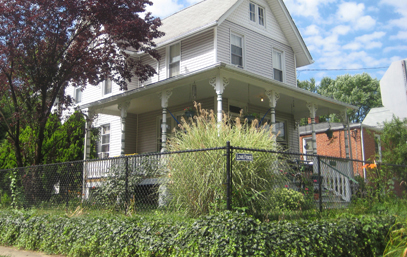Regardless of the purpose of your fence or the type of material you select, it is important to choose the best products in order to ensure a stable, long-lasting fence. As the best fence company in the nation, we’re here to help.
Four of the most important fencing components to help achieve longevity are the posts, gates, tension bands and ties and paint or stain, should your fence require staining.
Posts & Stakes
These structural components are pivotal in maintaining the integrity and durability of the fence. Posts or stakes provide a stable and robust framework that supports the entire fence structure. For wooden fences, the use of pressure-treated posts is highly recommended. This treatment process involves infusing the wood with preservatives, which significantly enhances its resistance to decay, rot, and insect infestation. As a result, pressure-treated posts can substantially prolong the lifespan of a wooden fence, maintaining its strength and aesthetic appeal over time.
When it comes to metal fences, the choice of posts becomes even more critical. Heavy-duty galvanized steel posts are considered the optimal choice for such fences. Galvanization is a process where steel is coated with a protective layer of zinc, which serves as a barrier against rust and corrosion. This treatment ensures that the metal posts can withstand harsh weather conditions, including heavy rain, snow, and extreme temperature fluctuations. The durability and strength of galvanized steel posts make them an excellent investment for metal fences, as they help maintain the fence’s structural integrity over many years. Additionally, these posts provide a sleek and modern appearance, complementing the aesthetic of metal fences and enhancing the overall look of the property they encircle.
Gates
Selecting the right gate for your fence is a crucial aspect of ensuring security and functionality. A gate is more than just a point of entry and exit; it serves as a critical security checkpoint, especially in enclosed areas like backyards, farms, or industrial premises.
When choosing a gate, it’s important to prioritize robust construction. Opt for a gate with at least two horizontal support bars. These bars add structural strength, allowing the gate to better resist sagging or warping over time. A well-constructed gate not only enhances security but also withstands regular use and the rigors of changing weather conditions.
The material of the gate, whether wood, metal, or another type, is also a key consideration. It’s essential to ensure that the gate is not flimsy and has enough durability to support weight. This is particularly important in scenarios where the gate might be leaned on or subjected to pressure. A sturdy gate, capable of holding weight, contributes to the overall safety of the fence structure. It’s a balance of aesthetic appeal, practicality, and safety – a gate that’s as reliable as it is visually pleasing ensures both the functionality and integrity of your fencing system.
Tension Bands and Ties
Tension bands play a vital role in the stability and durability of a chain link fence. They secure the fence fabric to the posts, ensuring the entire structure remains taut and stable. For maximum effectiveness, these bands should be made from high-grade galvanized steel. This material choice is crucial as it offers resistance to breakage and corrosion. Galvanized steel, treated to withstand the elements, ensures that the tension bands maintain their integrity and functionality over time, even in harsh weather conditions.
Similarly, the ties used in a chain link fence, which are responsible for attaching the fence fabric to the horizontal rails, are key. Galvanized steel guarantees that the ties remain firmly in place, resisting the potential for snapping, breaking, or rusting, particularly in wet weather.
Fence Paint/Stain
Regular maintenance through painting or staining acts as a protective barrier, safeguarding the wood from various weather conditions such as rain, sun, and wind. Choosing high-quality paint or stain for this purpose is essential. Opt for products that are specifically formulated for outdoor use and have a proven track record of durability. A good quality coating is worth it because it will enhance the fence’s resistance to weathering and look great without peeling or fading.
The frequency of repainting or restaining your wood fence depends on several factors, including the climate in your area, the type of wood used, and the quality of the previous coating. Generally, it’s recommended to repaint or restain the fence every one to three years. This helps preserve the wood and allows you to update or change the color scheme, keeping your fence looking fresh and new. Regular maintenance not only extends the fence’s life but also adds to your property’s curb appeal and value.
Read More:

